The Effects of Anthropomorphism, Message Framing, and Voice Type on Unhealthy Sleep Behavior in Young Users: The Mediating Role of Risk Perception
Abstract
1. Introduction
2. Literature Review
2.1. Anthropomorphism Design
2.2. Message Framing
2.3. Voice Type
2.4. The Mediating Role of Risk Perception
3. Methodology
3.1. Participants
3.2. Design
3.3. Measures
3.4. Procedure
4. Result
4.1. The Sample Profile
4.2. Manipulation Checks
4.3. Hypothesis Testing
4.4. Conditional Process Analysis
5. Discussion
5.1. Theoretical Implications
5.2. Practical Implications
5.3. Limitations and Directions for Future Research
6. Conclusions
Supplementary Materials
Author Contributions
Funding
Institutional Review Board Statement
Informed Consent Statement
Data Availability Statement
Conflicts of Interest
Appendix A
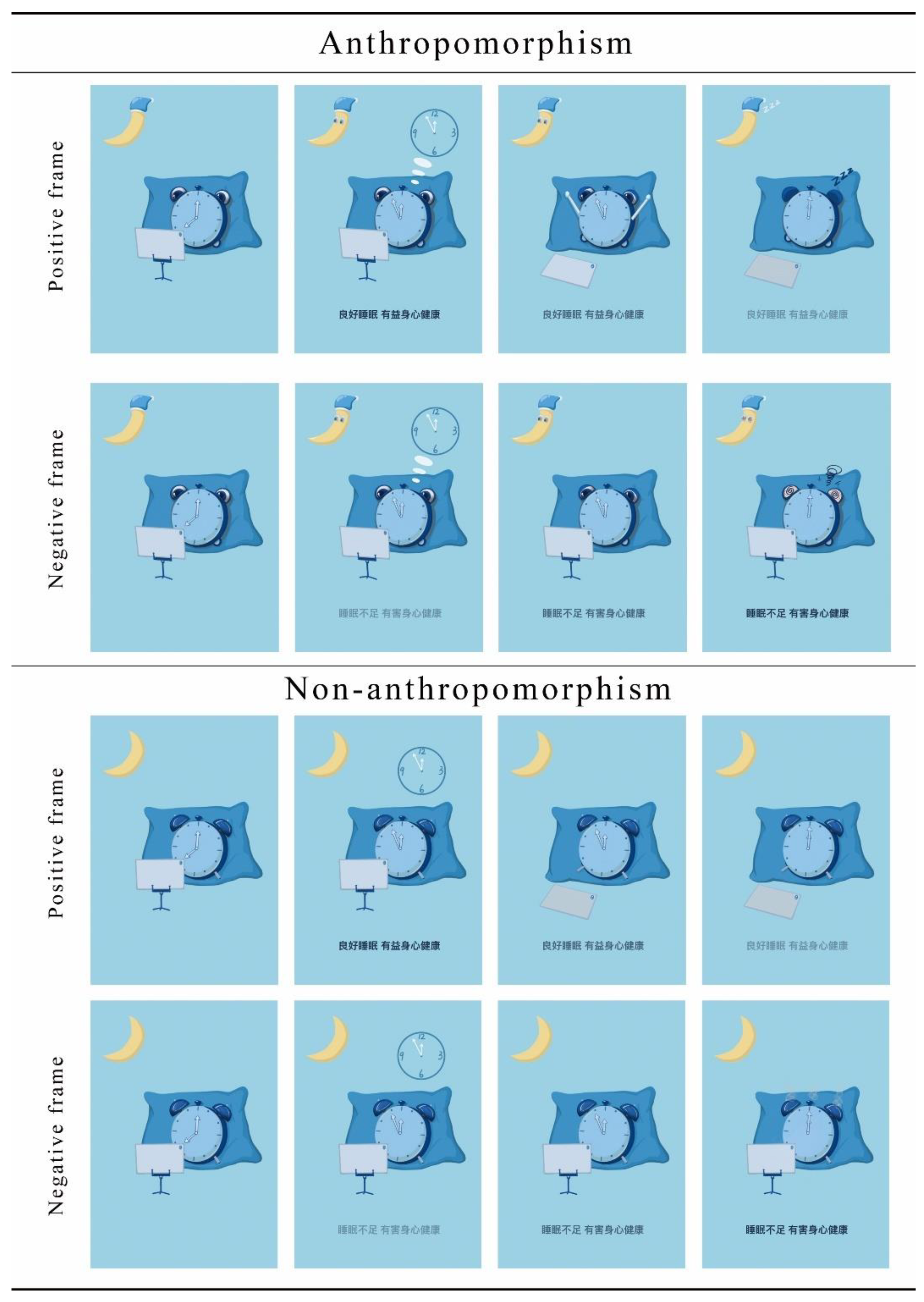
References
- Godsell, S.; White, J. Adolescent perceptions of sleep and influences on sleep behaviour: A qualitative study. J. Adolesc. 2019, 73, 18–25. [Google Scholar] [CrossRef] [PubMed]
- Roberts, R.E.; Roberts, C.R.; Xing, Y. Restricted sleep among adolescents: Prevalence, incidence, persistence, and associated factors. Behav. Sleep Med. 2011, 9, 18–30. [Google Scholar] [CrossRef] [PubMed]
- Markwald, R.R.; Melanson, E.L.; Smith, M.R.; Higgins, J.; Perreault, L.; Eckel, R.H.; Wright, K.P., Jr. Impact of insufficient sleep on total daily energy expenditure, food intake, and weight gain. Proc. Natl. Acad. Sci. USA 2013, 110, 5695–5700. [Google Scholar] [CrossRef] [PubMed]
- Taheri, S.; Lin, L.; Austin, D.; Young, T.; Mignot, E. Short sleep duration is associated with reduced leptin, elevated ghrelin, and increased body mass index. PLoS Med. 2004, 1, e62. [Google Scholar] [CrossRef] [PubMed]
- Nakashima, H.; Mita, Y.; Okuda, M.; Noda, A. Sleep-Wake Rhythm and Endothelial Function in Young. J. Hypertens. 2019, 37, e153. [Google Scholar] [CrossRef]
- Beck, A.J.; Duffett-Leger, L.; Bright, K.S.; Keys, E.M.; Hayden, A.; Ward, T.M.; Ferber, R. Using wearable and mobile technology to measure and promote healthy sleep behaviors in adolescents: A scoping review protocol. JBI Evid. Synth. 2021, 19, 2760–2769. [Google Scholar] [CrossRef]
- Glozier, N.; Martiniuk, A.; Patton, G.; Ivers, R.; Qiang, L.; Hickie, L.; Senserrick, T.; Woodward, M.; Norton, R.; Stenenson, M. Short Sleep Duration in Prevalent and Persistent Psychological Distress in Young Adults: The DRIVE Study. Sleep 2010, 33, 1139–1145. [Google Scholar] [CrossRef]
- Chen, M.C.; Burley, H.W.; Gotlib, I.H. Reduced sleep quality in healthy girls at risk for depression. J. Sleep Res. 2012, 21, 68–72. [Google Scholar] [CrossRef] [PubMed]
- Ban, D.J.; Lee, T.J. Sleep Duration, Subjective Sleep Disturbances and Associated Factors Among University Students in Korea. J. Korean Med. Sci. 2001, 16, 475–480. [Google Scholar] [CrossRef][Green Version]
- Stern, P. The many benefits of healthy sleep. Science 2021, 374, 550–551. [Google Scholar] [CrossRef]
- Rodger, L.; Dixey, J. Waking up to go to the toilet is the number one cause of a poor night’s sleep, say experts on World Sleep Day. Available online: https://www.ferring.com/waking-up-to-go-to-the-toilet-is-the-number-one-cause-of-a-poor-nights-sleep-say-experts-on-world-sleep-day/ (accessed on 11 June 2022).
- Depner, C.M.; Melanson, E.L.; Eckel, R.H.; Snell-Bergeon, J.K.; Perreault, L.; Bergman, B.C.; Higgins, J.A.; Guerin, M.K.; Stothard, E.R.; Morton, S.J.; et al. Ad libitum Weekend Recovery Sleep Fails to Prevent Metabolic Dysregulation during a Repeating Pattern of Insufficient Sleep and Weekend Recovery Sleep. Curr. Biol. 2019, 29, 957–967.e4. [Google Scholar] [CrossRef] [PubMed]
- Babicki, M.; Piotrowski, P.; Mastalerz-Migas, A. Assessment of Insomnia Symptoms, Quality of Life, Daytime Sleepiness, and Psychoactive Substance Use among Polish Students: A Cross-Sectional Online Survey for Years 2016–2021 before and during COVID-19 Pandemic. J. Clin. Med. 2022, 11, 2106. [Google Scholar] [CrossRef]
- Barnes, C.M.; Drake, C.L. Prioritizing Sleep Health: Public Health Policy Recommendations. Perspect. Psychol. Sci. 2015, 10, 733–737. [Google Scholar] [CrossRef] [PubMed]
- Glavin, E.E.; Matthew, J.; Spaeth, A.M. Gender Differences in the Relationship Between Exercise, Sleep, and Mood in Young Adults. Health Educ. Behav. 2022, 49, 128–140. [Google Scholar] [CrossRef] [PubMed]
- Hart, C.N.; Larose, J.G.; Fava, J.L.; James, B.L.; Wing, R.R. The association between time in bed and obesity risk in young adults. Behav. Sleep Med. 2013, 11, 321–327. [Google Scholar] [CrossRef] [PubMed]
- Rusnac, N.; Spitzenstetter, F.; Tassi, P. Chronic sleep loss and risk-taking behavior: Does the origin of sleep loss matter? Behav. Sleep Med. 2019, 17, 729–739. [Google Scholar] [CrossRef]
- Oh, Y.H.; Kim, H.; Kong, M.; Oh, B.; Moon, J.H. Association between weekend catch-up sleep and health-related quality of life of Korean adults. Medicine 2019, 98, e14966. [Google Scholar] [CrossRef] [PubMed]
- Haack, M.; Mullington, J.M. Sustained sleep restriction reduces emotional and physical well-being. Pain 2005, 119, 56–64. [Google Scholar] [CrossRef] [PubMed]
- Minkel, J.D.; Banks, S.; Htaik, O.; Moreta, M.C.; Jones, C.W.; McGlinchey, E.L.; Simpson, N.S.; Dinges, D.F. Sleep deprivation and stressors: Evidence for elevated negative affect in response to mild stressors when sleep deprived. Emotion 2012, 12, 1015–1020. [Google Scholar] [CrossRef]
- Roberts, R.E.; Duong, H.T. The prospective association between sleep deprivation and depression among adolescents. Sleep 2014, 37, 239–244. [Google Scholar] [CrossRef]
- Morita, Y.; Sasai-Sakuma, T.; Asaoka, S.; Inoue, Y. Prevalence and Correlates of Insufficient Sleep Syndrome in Japanese Young Adults: A Web-Based Cross-Sectional Study. J. Clin. Sleep Med. 2015, 11, 1163–1169. [Google Scholar] [CrossRef]
- Owens, J.; Au, R.; Carskadon, M.; Millman, R.; Wolfson, A.; Braverman, P.K.; Adelman, W.P.; Breuner, C.C.; Levine, D.A.; Marcell, A.V.; et al. Insufficient Sleep in Adolescents and Young Adults: An Update on Causes and Consequences. Pediatrics 2014, 134, e921–e932. [Google Scholar] [CrossRef] [PubMed]
- Hayley, A.C.; Skogen, J.C.; Overland, S.; Wold, B.; Williams, L.J.; Kennedy, G.A.; Sivertsen, B. Trajectories and stability of self-reported short sleep duration from adolescence to adulthood. J. Sleep Res. 2015, 24, 621–628. [Google Scholar] [CrossRef]
- Ahrberg, K.; Dresler, M.; Niedermaier, S.; Steiger, A.; Genzel, L. The interaction between sleep quality and academic performance. J. Psychiatr. Res. 2012, 46, 1618–1622. [Google Scholar] [CrossRef]
- Berking, M.; Wupperman, P. Emotion regulation and mental health: Recent findings, current challenges, and future directions. Curr. Opin. Psychiatry 2012, 25, 128–134. [Google Scholar] [CrossRef]
- Millman, R.P. Excessive Sleepiness in Adolescents and Young Adults: Causes, Consequences, and Treatment Strategies. Pediatrics 2005, 115, 1774–1786. [Google Scholar] [CrossRef]
- Hysing, M.; Pallesen, S.; Stormark, K.M.; Jakobsen, R.; Lundervold, A.J.; Sivertsen, B. Sleep and use of electronic devices in adolescence: Results from a large population-based study. BMJ Open 2015, 5, e006748. [Google Scholar] [CrossRef]
- Schweizer, A.; Berchtold, A.; Barrense-Dias, Y.; Akre, C.; Suris, J.C. Adolescents with a smartphone sleep less than their peers. Eur. J. Pediatr. 2017, 176, 131–136. [Google Scholar] [CrossRef]
- Simor, P.; Krietsch, K.N.; Koteles, F.; McCrae, C.S. Day-to-Day Variation of Subjective Sleep Quality and Emotional States among Healthy University Students—A 1-Week Prospective Study. Int. J. Behav. Med. 2015, 22, 625–634. [Google Scholar] [CrossRef]
- Blake, M.J.; Sheeber, L.B.; Youssef, G.J.; Raniti, M.B.; Allen, N.B. Systematic Review and Meta-analysis of Adolescent Cognitive-Behavioral Sleep Interventions. Clin. Child Fam. Psychol. Rev. 2017, 20, 227–249. [Google Scholar] [CrossRef]
- Cain, N.; Gradisar, M.; Moseley, L. A motivational school-based intervention for adolescent sleep problems. Sleep Med. 2011, 12, 246–251. [Google Scholar] [CrossRef] [PubMed]
- Filion, A.J.; Darlington, G.; Chaput, J.P.; Ybarra, M.; Haines, J. Examining the influence of a text message-based sleep and physical activity intervention among young adult smokers in the United States. BMC Public Health 2015, 15, 671. [Google Scholar] [CrossRef] [PubMed]
- Huang, W.H. Get Rid of Mr. Virus: The Effect of Injurant Anthropomorphism on the Intention to Engage in Protective Behavior. Health Commun. 2021. [Google Scholar] [CrossRef] [PubMed]
- Janz, N.K.; Becker, M.H. The Health Belief Model: A decade later. Health Educ. Q. 1984, 11, 1–47. [Google Scholar] [CrossRef] [PubMed]
- Taylor, S.E.; Thompson, S.C. Stalking the elusive “vividness” effect. Psychol. Rev. 1982, 89, 155–181. [Google Scholar] [CrossRef]
- Romero, J.; Lado, N. Service robots and COVID-19: Exploring perceptions of prevention efficacy at hotels in generation Z. Int. J. Contemp. Hosp. Manag. 2021, 33, 4057–4078. [Google Scholar] [CrossRef]
- Muzumdar, J.M.; Schommer, J.C.; Hadsall, R.S.; Huh, J. Effects of anthropomorphic images and narration styles in promotional messages for generic prescription drugs. Res. Social Adm. Pharm. 2013, 9, 60–79. [Google Scholar] [CrossRef] [PubMed]
- Sah, Y.J.; Peng, W. Effects of visual and linguistic anthropomorphic cues on social perception, self-awareness, and information disclosure in a health website. Comput. Hum. Behav. 2015, 45, 392–401. [Google Scholar] [CrossRef]
- Guan, M.; So, J. Tailoring Temporal Message Frames to Individuals’ Time Orientation Strengthens the Relationship between Risk Perception and Behavioral Intention. J. Health Commun. 2020, 25, 971–981. [Google Scholar] [CrossRef]
- Ajzen, I.; Fishbein, M. Attitudes and the Attitude-Behavior Relation: Reasoned and Automatic Processes. Eur. Rev. Soc. Psychol. 2011, 11, 1–33. [Google Scholar] [CrossRef]
- Steinmetz, H.; Knappstein, M.; Ajzen, I.; Schmidt, P.; Kabst, R. How effective are behavior change interventions based on the theory of planned behavior? A three-level meta-analysis. Z. Psychol. 2016, 224, 216–233. [Google Scholar] [CrossRef]
- Branscum, P.; Fay, K.Q.; Senkowski, V. Do different factors predict the adoption and maintenance of healthy sleep behaviors? A reasoned action approach. Transl. Behav. Med. 2020, 10, 78–86. [Google Scholar] [CrossRef] [PubMed]
- Epley, N.; Waytz, A.; Cacioppo, J.T. On seeing human: A three-factor theory of anthropomorphism. Psychol. Rev. 2007, 114, 864–886. [Google Scholar] [CrossRef] [PubMed]
- Onnasch, L.; Roesler, E. Anthropomorphizing Robots: The Effect of Framing in Human-Robot Collaboration. Proc. Hum. Factors Ergon. Soc. Annu. Meet. 2019, 63, 1311–1315. [Google Scholar] [CrossRef]
- Shao, X.; Jeong, E.; Jang, S.; Xu, Y. Mr. Potato Head fights food waste: The effect of anthropomorphism in promoting ugly food. Int. J. Hosp. Manag. 2020, 89, 102521. [Google Scholar] [CrossRef]
- Karpinska-Krakowiak, M.; Skowron, L.; Ivanov, L. “I Will Start Saving Natural Resources, Only When You Show Me the Planet as a Person in Danger”: The Effects of Message Framing and Anthropomorphism on Pro-Environmental Behaviors that are Viewed as Effortful. Sustainability 2020, 12, 5524. [Google Scholar] [CrossRef]
- Li, X.; Sung, Y. Anthropomorphism brings us closer: The mediating role of psychological distance in User–AI assistant interactions. Comput. Hum. Behav. 2021, 118, 106680. [Google Scholar] [CrossRef]
- Vidal, D. Anthropomorphism or sub-anthropomorphism? An anthropological approach to gods and robots. J. R. Anthropol. Inst. 2007, 13, 917–933. [Google Scholar] [CrossRef]
- Sreejesh, S.; Paul, J.; Strong, C.; Pius, J. Consumer response towards social media advertising: Effect of media interactivity, its conditions and the underlying mechanism. Int. J. Inf. Manag. 2020, 54, 102155. [Google Scholar] [CrossRef]
- Block, L.G.; Keller, P.A. Effects of Self-Efficacy and Vividness on the Persuasiveness of Health Communications. J. Consum. Psychol. 1997, 6, 31–54. [Google Scholar] [CrossRef]
- Burgoon, J.K.; Bonito, J.A.; Bengtsson, B.; Cederberg, C.; Lundeberg, M.; Allspach, L. Interactivity in human–computer interaction: A study of credibility, understanding, and influence. Comput. Hum. Behav. 2000, 16, 553–574. [Google Scholar] [CrossRef]
- Amos, T.; Daniel, K. The Framing of Decisions and the Psychology of Choice. Science 1981, 211, 453–458. [Google Scholar]
- Liu, S.; Yang, J.Z. Incorporating Message Framing into Narrative Persuasion to Curb E-Cigarette Use Among College Students. Risk Anal. 2020, 40, 1677–1690. [Google Scholar] [CrossRef] [PubMed]
- Cho, J.; Chun, J.W.; Lee, M.J. Impacts of Message Framing and Social Distance in Health Campaign for Promoting Regular Physical Exercise. J. Health Commun. 2018, 23, 824–835. [Google Scholar] [CrossRef] [PubMed]
- Goh, M.C.W.; Kelly, P.J.; Deane, F.P. Enhancing Type 2 diabetes risk communication with message framing and tailored risk feedback: An online randomised controlled trial. Aust. J. Psychol. 2021, 73, 499–511. [Google Scholar] [CrossRef]
- Nan, X. Communicating to young adults about HPV vaccination: Consideration of message framing, motivation, and gender. Health Commun. 2012, 27, 10–18. [Google Scholar] [CrossRef] [PubMed]
- Gursoy, D.; Ekinci, Y.; Can, A.S.; Murray, J.C. Effectiveness of message framing in changing COVID-19 vaccination intentions: Moderating role of travel desire. Tour. Manag. 2022, 90, 104468. [Google Scholar] [CrossRef]
- O’Keefe, D.J.; Jensen, J.D. The Advantages of Compliance or the Disadvantages of Noncompliance? A Meta-Analytic Review of the Relative Persuasive Effectiveness of Gain-Framed and Loss-Framed Messages. Ann. Int. Commun. Assoc. 2016, 30, 1–43. [Google Scholar] [CrossRef]
- O’Keefe, D.J.; Jensen, J.D. The relative persuasiveness of gain-framed and loss-framed messages for encouraging disease prevention behaviors: A meta-analytic review. J. Health Commun. 2007, 12, 623–644. [Google Scholar] [CrossRef] [PubMed]
- O’Keefe, D.J.; Jensen, J.D. The Relative Persuasiveness of Gain-Framed and Loss-Framed Messages for Encouraging Disease Detection Behaviors: A Meta-Analytic Review. J. Commun. 2009, 59, 296–316. [Google Scholar] [CrossRef]
- Rothman, A.J.; Salovey, P. Shaping perceptions to motivate healthy behavior: The role of message framing. Psychol. Bull. 1997, 121, 3–19. [Google Scholar] [CrossRef]
- de Bruijn, G.J.; Spaans, P.; Jansen, B.; van’t Riet, J. Testing the effects of a message framing intervention on intentions towards hearing loss prevention in adolescents. Health Educ. Res. 2016, 31, 161–170. [Google Scholar] [CrossRef] [PubMed]
- Arora, R.; Stoner, C.; Arora, A. Using framing and credibility to incorporate exercise and fitness in individuals’ lifestyle. J. Consum. Mark. 2006, 23, 199–207. [Google Scholar] [CrossRef]
- Kim, S.; McGill, A.L. Gaming with Mr. Slot or Gaming the Slot Machine? Power, Anthropomorphism, and Risk Perception. J. Consum. Res. 2011, 38, 94–107. [Google Scholar] [CrossRef]
- Wuth, J.; Correa, P.; Núñez, T.; Saavedra, M.; Yoma, N.B. The Role of Speech Technology in User Perception and Context Acquisition in HRI. Int. J. Soc. Robot. 2020, 13, 949–968. [Google Scholar] [CrossRef]
- Seungho, H.; Jungpyo, H.; Sangbae, J.; Minsoo, H. Robust GSC-based Speech Enhancement for Human Machine Interface. IEEE Trans. Consum. Electron. 2010, 56, 965–970. [Google Scholar] [CrossRef]
- Potter, R.F.; Choi, J. The Effects of Auditory Structural Complexity on Attitudes, Attention, Arousal, and Memory. Media Psychol. 2006, 8, 395–419. [Google Scholar] [CrossRef]
- Wiener, H.J.D.; Chartrand, T.L. The Effect of Voice Quality on Ad Efficacy. Psychol. Mark. 2014, 31, 509–517. [Google Scholar] [CrossRef]
- Casado-Aranda, L.A.; Martinez-Fiestas, M.; Sanchez-Fernandez, J. Neural effects of environmental advertising: An fMRI analysis of voice age and temporal framing. J. Environ. Manage 2018, 206, 664–675. [Google Scholar] [CrossRef]
- Schneider, T.R.; Salovey, P.; Pallonen, U.; Mundorf, N.; Smith, N.F.; Steward, W.T. Visual and Auditory Message Framing Effects on Tobacco Smoking. J. Appl. Soc. Psychol. 2001, 31, 667–682. [Google Scholar] [CrossRef]
- Dou, X.; Wu, C.-F.; Niu, J.; Pan, K.-R. Effect of Voice Type and Head-Light Color in Social Robots for Different Applications. Int. J. Soc. Robot. 2021, 14, 229–244. [Google Scholar] [CrossRef]
- Berry, D.S. Vocal types and stereotypes: Joint effects of vocal attractiveness and vocal maturity on person perception. J. Nonverbal Behav. 1992, 16, 41–54. [Google Scholar] [CrossRef]
- Apple, W.; Streeter, L.A.; Krauss, R.M. Effects of pitch and speech rate on personal attributions. J. Personal. Soc. Psychol. 1979, 37, 715–727. [Google Scholar] [CrossRef]
- Kano, T.; Takamichi, S.; Sakti, S.; Neubig, G.; Toda, T.; Nakamura, S. An end-to-end model for cross-lingual transformation of paralinguistic information. Mach. Transl. 2018, 32, 353–368. [Google Scholar] [CrossRef]
- Lu, H.; Siemer, W.F.; Baumer, M.S.; Decker, D.J. Exploring the role of gain versus loss framing and point of reference in messages to reduce human–bear conflicts. Soc. Sci. J. 2019, 55, 182–192. [Google Scholar] [CrossRef]
- Ma, Z.; Nan, X. Positive Facts, Negative Stories: Message Framing as a Moderator of Narrative Persuasion in Antismoking Communication. Health Commun. 2019, 34, 1454–1460. [Google Scholar] [CrossRef] [PubMed]
- Mitchell, V.W.; Bakewell, C.; Jackson, P.; Heslin, C. How message framing affects consumer attitudes in food crises. Br. Food J. 2015, 117, 2200–2211. [Google Scholar] [CrossRef]
- Jin, E.; Atkinson, L. The Moderating Role of Emotion: The Combinatory Effects of Positive Emotion and News Framing Techniques on Climate Change Attitudes. J. Mass Commun. Q. 2021, 98, 749–768. [Google Scholar] [CrossRef]
- Hayes, A.F. Introduction to Mediation, Moderation, and Conditional Process Analysis; Guilford Publications: New York, NY, USA, 2013. [Google Scholar]
- Newton, F.J.; Newton, J.D.; Wong, J. This is your stomach speaking: Anthropomorphized health messages reduce portion size preferences among the powerless. J. Bus. Res. 2017, 75, 229–239. [Google Scholar] [CrossRef]
- Sundar, S.S.; Kim, J. Interactivity and Persuasion. J. Interact. Advert. 2005, 5, 5–18. [Google Scholar] [CrossRef]
- Witte, K.; Cameron, K.A.; McKeon, J.K.; Berkowitz, J.M. Predicting risk behaviors: Development and validation of a diagnostic scale. J. Health Commun. 1996, 1, 317–341. [Google Scholar] [CrossRef] [PubMed]
- Robbins, R.; Niederdeppe, J. Testing the Role of Narrative and Gain-Loss Framing in Messages to Promote Sleep Hygiene among High School Students. J. Health Commun. 2019, 24, 84–93. [Google Scholar] [CrossRef] [PubMed]
- Han, B.; Wang, L.; Li, X. To Collaborate or Serve? Effects of Anthropomorphized Brand Roles and Implicit Theories on Consumer Responses. Cornell Hosp. Q. 2019, 61, 53–67. [Google Scholar] [CrossRef]
- Han, H.-E.; Cui, G.-Q.; Jin, C.-H.; Foroudi, P. The role of human brands in consumer attitude formation: Anthropomorphized messages and brand authenticity. Cogent Bus. Manag. 2021, 8, 1923355. [Google Scholar] [CrossRef]
- Osinski, B.L.; Getson, J.M.; Bentlage, B.; Avery, G.; Glas, Z.; Esman, L.A.; Williams, R.N.; Prokopy, L.S. What’s the draw? Illustrating the impacts of cartoons versus photographs on attitudes and behavioral intentions for wildlife conservation. Hum. Dimens. Wildl. 2019, 24, 231–249. [Google Scholar] [CrossRef]
- Rauschnabel, P.A.; Ahuvia, A.C. You’re so lovable: Anthropomorphism and brand love. J. Brand Manag. 2014, 21, 372–395. [Google Scholar] [CrossRef]

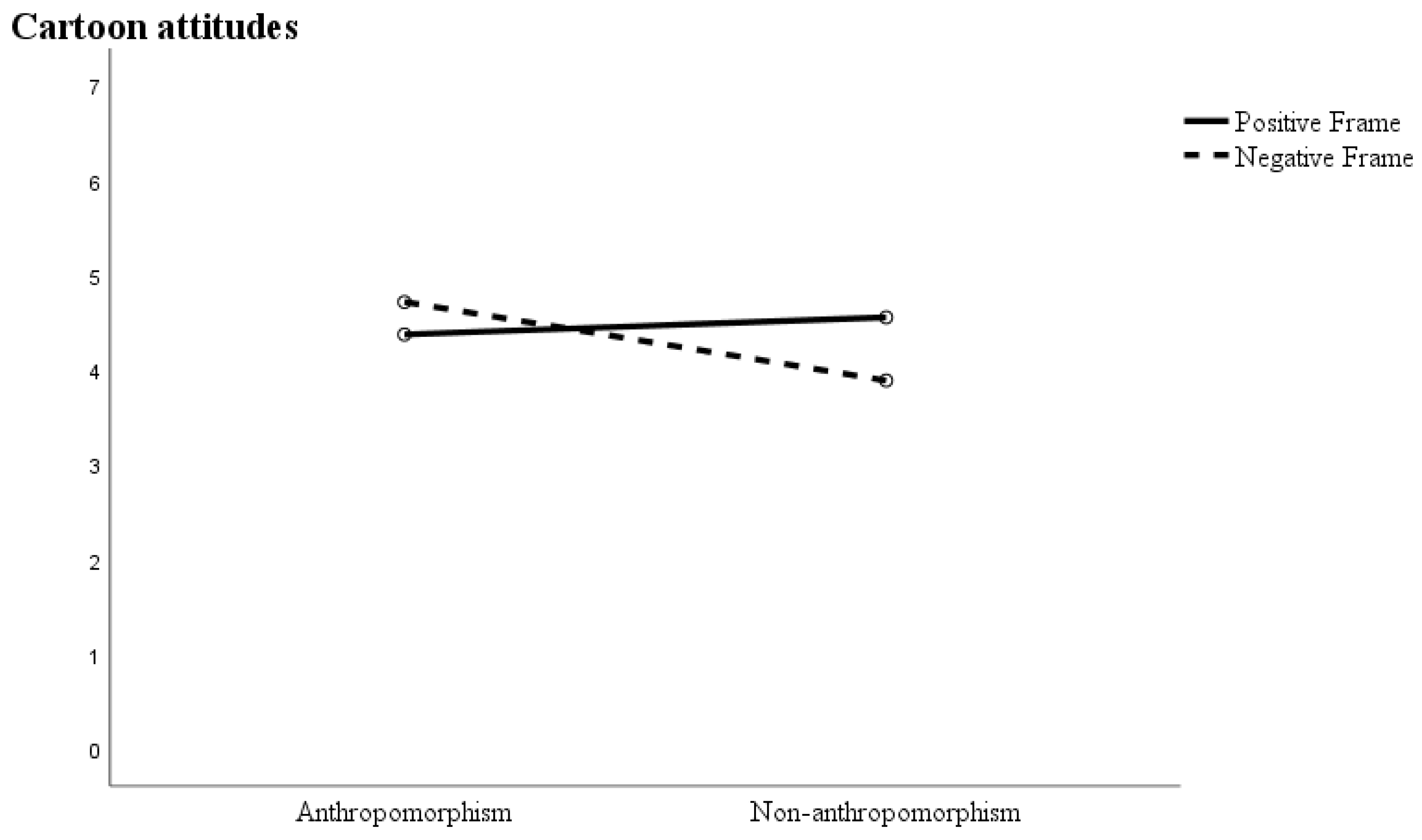

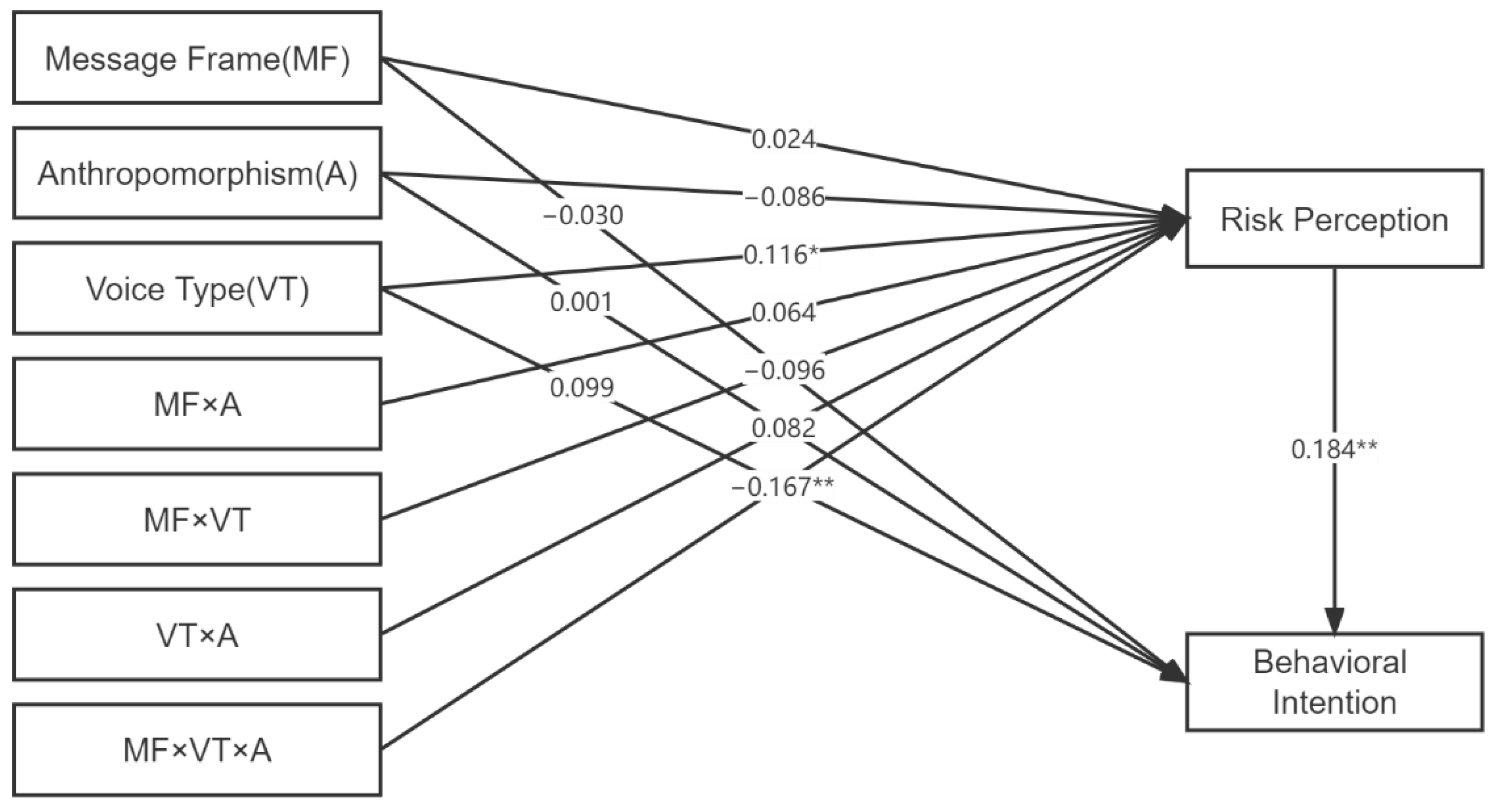
| Independent Variable | Level | |
|---|---|---|
| Anthropomorphic | Non-anthropomorphic | Anthropomorphic |
 | ||
 | ||
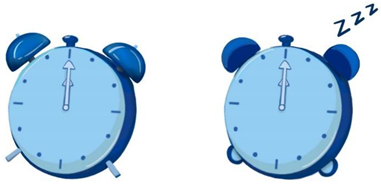 | ||
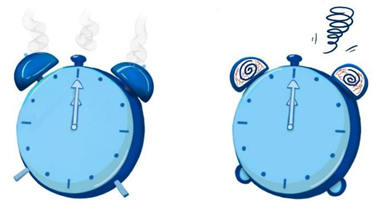 | ||
| Message framing | Positive frame | Negative frame |
| Good sleep is good for physical and mental health. | Lack of sleep is harmful to physical and mental health. | |
| Voice type | Cartoon child voice | Adult female voice |
| Healthy sleep, developing a scientifically regular life, and rest are beneficial to physical and mental health | Lack of sleep, inability to develop a scientifically regular life, and lack of rest will harm physical and mental health | |
| Characteristics | N | Percentage |
|---|---|---|
| Gender | ||
| Male | 105 | 50.7 |
| Female | 102 | 49.3 |
| Age | ||
| 15–18 years | 1 | 0.5 |
| 19–22 years | 85 | 41.1 |
| 23–26 years | 117 | 56.5 |
| 28–30 years | 2 | 1.0 |
| 31–34 years | 2 | 1.0 |
| Education | ||
| High school/Secondary school/Technical school student | 2 | 1.0 |
| College students | 9 | 4.3 |
| Undergraduate student | 115 | 55.6 |
| Graduate student | 79 | 38.2 |
| Doctoral student | 2 | 1.0 |
| Sources of Variation | Cartoon Attitudes | Risk Perception | Behavioral Intention | ||||
|---|---|---|---|---|---|---|---|
| F Value | η2 | F Value | η2 | F Value | η2 | ||
| Anthropomorphism (A) | (1,199) | 4.72 ** | 0.02 | 1.32 | 0.01 | 0.02 | 0.00 |
| Message Frame (MF) | (1,199) | 1.17 | 0.01 | 0.34 | 0.00 | 0.06 | 0.00 |
| Voice Type (VT) | (1,199) | 1.16 | 0.01 | 3.47 * | 0.02 | 3.38 * | 0.02 |
| A × MF | (1,199) | 11.41 **** | 0.05 | 0.79 | 0.00 | 0.14 | 0.00 |
| A × VT | (1,199) | 0.12 | 0.00 | 1.25 | 0.01 | 1.30 | 0.01 |
| MF × VT | (1,199) | 0.08 | 0.00 | 3.25 * | 0.02 | 3.02 * | 0.02 |
| A × MF × VT | (1,199) | 0.35 | 0.00 | 5.89 ** | 0.03 | 3.19 * | 0.02 |
Publisher’s Note: MDPI stays neutral with regard to jurisdictional claims in published maps and institutional affiliations. |
© 2022 by the authors. Licensee MDPI, Basel, Switzerland. This article is an open access article distributed under the terms and conditions of the Creative Commons Attribution (CC BY) license (https://creativecommons.org/licenses/by/4.0/).
Share and Cite
Li, Y.; Zhu, Y.; Zhang, G.; Zhou, J.; Liu, J.; Li, Z.; He, B. The Effects of Anthropomorphism, Message Framing, and Voice Type on Unhealthy Sleep Behavior in Young Users: The Mediating Role of Risk Perception. Int. J. Environ. Res. Public Health 2022, 19, 9570. https://doi.org/10.3390/ijerph19159570
Li Y, Zhu Y, Zhang G, Zhou J, Liu J, Li Z, He B. The Effects of Anthropomorphism, Message Framing, and Voice Type on Unhealthy Sleep Behavior in Young Users: The Mediating Role of Risk Perception. International Journal of Environmental Research and Public Health. 2022; 19(15):9570. https://doi.org/10.3390/ijerph19159570
Chicago/Turabian StyleLi, Ying, Yanfei Zhu, Guanqun Zhang, Junliang Zhou, Jinlai Liu, Zhuoxin Li, and Boqian He. 2022. "The Effects of Anthropomorphism, Message Framing, and Voice Type on Unhealthy Sleep Behavior in Young Users: The Mediating Role of Risk Perception" International Journal of Environmental Research and Public Health 19, no. 15: 9570. https://doi.org/10.3390/ijerph19159570
APA StyleLi, Y., Zhu, Y., Zhang, G., Zhou, J., Liu, J., Li, Z., & He, B. (2022). The Effects of Anthropomorphism, Message Framing, and Voice Type on Unhealthy Sleep Behavior in Young Users: The Mediating Role of Risk Perception. International Journal of Environmental Research and Public Health, 19(15), 9570. https://doi.org/10.3390/ijerph19159570





